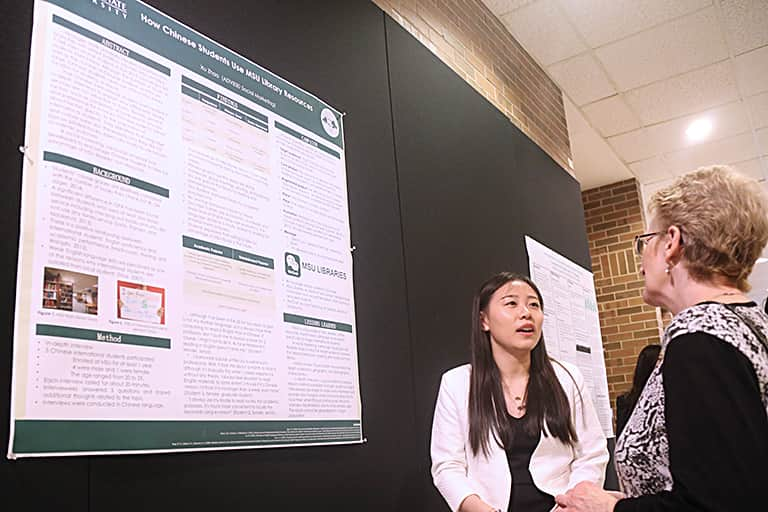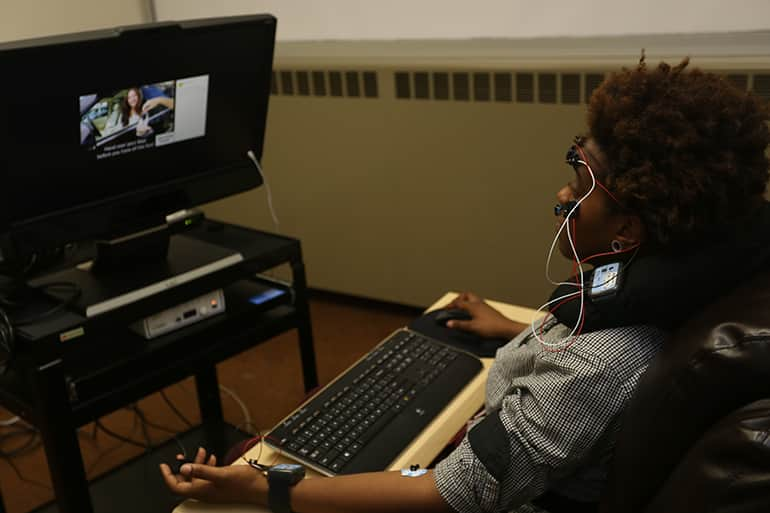Anastasia G Kononova

Associate Professor
Department
- Advertising + Public Relations
(517) 432-5129
Download CV
Bio
Anastasia Kononova is an associate professor of advertising at MSU. Media multitasking is an overarching focus of Kononova's interdisciplinary and international research that lies in the intersection of three areas: media and technology use across different cultures and social groups; psychological responses to media devices and persuasive messages; and advertising and digital literacy. Kononova's primary research interest is related to exploring media multitasking behavior, i.e. using/being exposed to multiple media at the same time. Studying media multitasking patterns reflects idiosyncrasies and commonalities of media use across markets. Such knowledge helps enhance international communication, especially with regard to using multiple platforms to convey messages effectively. Kononova has studied media multitasking not only in a cross-cultural setting but also across the lifespan, focusing on media use behaviors of older adults.
A large body of Kononova's media multitasking research is devoted to exploring the effects of this behavior on cognition, emotion, rationalization, and resistance to persuasion. Kononova has found that switching between online tasks and using multiple screen devices at the same time negatively affect memory for mediated content, elicit less skeptical responses to persuasive messages (e.g., health and advertising messages), and hinder rational choices (e.g., choice of healthful snacks). In a related area of research, Kononova has explored how individuals cognitively and affectively respond to advertising messages placed in congruent and incongruent online contexts.
In a recent project, Kononova focused on the use of health mobile applications (apps) and privacy concerns associated with sharing personal information via smartphones, exploring credibility judgments that individuals made of sponsored health mobile apps.
Kononova's word appeared in highly ranked peer-reviewed journals, such as Computers in Human Behavior, Cyberpsychology, Behavior, and Social Networking, International Journal of Communication, Journal of Health Communication, Journal of Medical Internet Research: mHealth and uHealth, and others.
Before joining the Department of Advertising and Public Relations at Michigan State University, Anastasia worked as an assistant professor of communication and media at the American University of Kuwait. She earned a doctoral degree at the University of Missouri’s School of Journalism and a master’s degree at Oklahoma State University. Before graduate school, Anastasia studied in Rostov State University (Southern Federal University since 2006) in Russia, where she also worked as a corporate communication specialist.
Roles
Research: Selected articles & book chapters
Kononova, A., Joshi, P., & Cotten, S. (Accepted for publication). Dispelling the myth: Older adults multitask with media and technologies but studying their multitasking behaviors can be challenging. Innovation in Aging.
Li, L., Peng, W., Kononova, A., Bowen M., & Cotton, S. (Accepted for publication). Factors Associated with Older Adults’ Long-Term Use of Wearable Activity Trackers. Telemedicine & e-Health.
Kononova, A., Li, L., Kamp, K., Bowen, M., Rikard, R., Cotten, S., & Peng, W. (2019). The use of wearable activity trackers among older adults: A focus group study of tracker perceptions, motivators, and barriers in different stages of behavior change. Journal of Medical Internet Research: mHealth and uHealth.
Alhabash, S., Cunningham, C., & Kononova, A. (2019). Who is American?. In M. E. Len-Rios & E. Perry (Eds.), Cross-Cultural Journalism. Routledge.
Lin, T.C., Kononova, A., & Chiang, Y-H. (2019). Linking media multitasking to screen addiction among Internet users in the United States and Taiwan. Journal of Computer Information Systems.
Wasserman, J.A., Kononova, A., Moldovan, T., & Cotten, S.R. (2018). A pilot study of multitasking among medical students. Medical Science Educator.
Segijn, C. & Kononova A. (2018). Audience, media, and cultural factors as predictors of multiscreen use: A comparative study of the United States and the Netherlands." International Journal of Communication.
Kononova, A., McAlister, A., & Oh, H.J. (2018). Screen overload: Pleasant multitasking with screen devices leads to the choice of healthful over less healthful snacks when compared with unpleasant multitasking. Computers in Human Behavior, 80, 1-11. First published online on October 27, 2017.
Kanthawala, S., Joo, E., Kononova, A., Peng, W., & Cotten, S. (2018). Folk theorizing the quality and credibility of health apps. Mobile Media and Communication, 2050157918796859.
Deng, T., Kanthawala, S., Hao, Q., Meng, J., Peng, W., Kononova, A., Zhang, Q., & David, P. (2018). Measuring Smartphone Usage and Task-Switching with Objective Tracking and Self-Reports: An Exploratory Study. Mobile Media & Communication. First published online on April 25, 2018.
Kononova, A., Yuan, S., & Joo, E. (2017). Reading about the flu online: How health-protective behavioral intentions are influenced by media multitasking, polychronicity, and strength of health-related arguments. Journal of Health Communication, 32(6), 759-767.
Kononova, A., Joo, E., & Yuan, S. (2016). If I choose when to switch: Heavy multitaskers remember online content better than light multitaskers when they have the freedom to multitask. Computers in Human Behavior, 65, 567-575.
Kononova, A., & Yuan, S. (2016). Take a break: Examining college students’ media multitasking activities and motivations during study- or work-related tasks. Journalism and Mass Communication Educator, 72(2), 183-197.
Kononova, A., & Chiang, J. (2015). Why do we multitask with media? Predictors of media multitasking among Internet users in the United States and Taiwan. Computers in Human Behavior, 50, 31-41.
Kononova, A., & Yuan, S. (2015). Double-dipping effect? How combining YouTube environmental PSAs with thematically congruent advertisements in different formats affects memory and attitudes. Journal of Interactive Advertising, 15(1), 2-15.
Kononova, A., & Akbar, M. (2015). Interpersonal communication, media exposure, opinion leadership, and perceived credibility of news and advertising during December 2012 parliamentary election in Kuwait. International Journal of Communication, 9, 1206-1228.
Kononova, A., Zasorina, T., Diveeva, N., Kokoeva, A., & Chelokyan, A. (2014). Multitasking goes global: multitasking with traditional and new electronic media and attention to media messages among college students in Kuwait, Russia, and the United States. International Communication Gazette, 76(8), 617-640.
Kononova, A. (2013). Multitasking across borders: A cross-national study of media multitasking behaviors, its antecedents, and outcomes. International Journal of Communication, 7, 1-20.
Kononova, A. (2013). Effects of distracting ads and cognitive control on the processing of online news stories with stereotype-related information. Cyberpsychology, Behavior, & Social Networking, 16(5), 321-328.
Alhabash, S., Park, H.-J., Kononova, A., Chiang, J., & Wise, K. (2012). Exploring the motivations of Facebook use in Taiwan. Cyberpsychology, Behavior, & Social Networking, 15(6), 304-311.
Kononova, A., Alhabash, S., & Cropp, F. (2011). The role of media in socialization to American politics among international students. International Communication Gazette, 73(4), 302-321.
Wise, K., Eckler, P., Kononova, A., & Littau, J. (2009). Exploring the “wire” in the hardwired for news hypothesis: How threat proximity affects the cognitive and emotional processing of health-related news. Communication Studies, 60(3), 268-287.
Teaching: Course descriptions
ADV 350 Media Planning & Strategy: The purpose of the course is to introduce students to the basic principles of advertising media planning and buying and enhance their skills in creating successful media plans. Students will learn how to set objectives, develop strategies, and choose tactics to achieve communication goals. They will practice situation analysis, including the analysis of target audiences and competitors. They will refine their decision-making skills in choosing media to communicate promotional messages and acquire hands-on experience with media planning math, budgeting, scheduling, and database work.
ADV 442 Digital Analytics: Digital analytics is involved in a chain of crucial business intelligence elements. Students learn how to collect data using digital media, analyze them in Excel and other offline and online software, interpret digital analytics trends, and report these trends to clients in advertising, public relations, and other mediated communication areas. The learning objectives of the course include: developing skills to use digital analytics tools; interpreting the trends uncovered through using digital analytics tools; and practicing effective communication of digital analytics findings using various message formats.
ADV 830 Social Marketing: The goal of this course is to teach students how marketing, branding, and other commercial strategic communication tools can be used to improve life in the society. Students learn how to define social good and a cause, what is the difference between social and commercial marketing, who are the stakeholders in social marketing campaigns, how to appeal to target audience's values, and how to develop and evaluate an effective social marketing strategy. In addition, students obtain and/or refine skills to conduct primary and secondary research, critically assess previous social marketing campaigns, and learn about persuasion theories.
ADV/JOURN921 Media Theory: The seminar covers theories that are widely used in the field of mediated (mass) communication. The topic areas include media, technology, and information; communication; persuasion, strategic communication; journalism, among others. Students discuss fundamental theories that connect the fields of advertising/PR, journalism, and media & information and analyze different theoretical approaches from social science to critical theory and cultural studies. The review of theories is a good introduction to media and information studies that helps students start building scholarly identity, find theories that they want to work with, and develop ideas that they want to be known for.
Research and Teaching
Research Centers and Labs
Media and Advertising Psychology Lab
Health and Risk Communication Center
Related Work

Graduate Students Recognized at Research and Arts Poster Forum
Read more

Measuring the Impact of Mediated Communication
Read more

Anastasia Kononova Named One of the Most Prolific Media Multitasking Researchers
Read more

MSU researchers investigate counterfeiting attitudes and behaviors with global survey
Read more

MSU survey: 7 in 10 consumers deceived into buying counterfeit products online
Read more

MSU Department of Advertising and Public Relations launches new textbook
Read more
